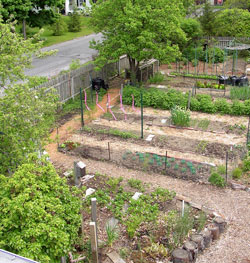Homegrown food
 ©Janet Allen
©Janet Allen Delicious (and productive) kale
Even in our smallish (80 ft x 180 ft) urban-suburban yard, we grow lots of our own food.
The last few years, we have produced 500-600 pounds of food each summer. That's a lot when you consider how much lettuce, for example, there is in a pound! Of course, heftier vegetables, such as tomatoes and summer squash, boosts our total, too.
More nutritious and delicious
 ©Janet Allen
©Janet Allen Delicious home-grown beans
And though there is no way we can prove it, I suspect our food is more nutritious than any we could get elsewhere. Why? Because food incorporates the minerals in soil, and our soil is likely to be much healthier than soil elsewhere—certainly healthier than any soil depleted by industrial agriculture's monocultures and emphasis on adding just a few chemical to boost production.
In addition, we can choose varieties of fruits and vegetables that are just good food, not commercial varieties whose main characteristic is that they all ripen at the same time or can survive long trips on a truck.
 ©Janet Allen
©Janet Allen Purslane: volunteer food
The easiest food to grow is purslane—no effort at all since it has been one of our most common weeds as long as we've lived here. And to think that we threw it out for years!
And when the time between harvest and eating can be measured in minutes, not days (or possibly weeks), fewer vitamins and minerals are lost.
Besides being the most sustainable way to produce our food, it's also a way to produce delicious food. Our raspberries, for example, are the kind of fruit that money can't buy (or at least reasonable amounts of money…)
Room to grow
 ©Janet Allen
©Janet Allen Most of our vegetable garden area
How to we have space enough to grow so much food? We don't have any lawn to speak of! Lawn is a real waste of soil and space.
More about our edible garden is on Our Edible Garden website.
More about reducing our lawn is on Our Habitat Garden website.
